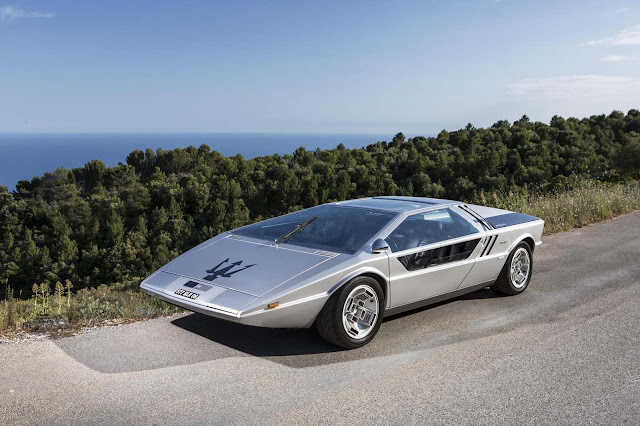Seller's Description
1972 Maserati Boomerang Coupé
Coachwork by Italdesign
Chassis no. 081
Engine no. 902
*Unique, one-off concept car
*Fully functional
*Multiple concours winner
*Road registered
First seen as a concept car at the Turin Motor Show in 1971, the Maserati Boomerang was a typically adventurous work by the man who would later be judged 'Car Designer of the Century': Giorgetto Giugiaro. Born into a family of artists - his father and grandfather were painters - Giorgetto Giugiaro inherited their creative flair, attending the Turin Art School where his imaginative car-design sketches were noticed by Dante Giacosa, FIAT's Technical Director. He was offered a job and began working in the company's design office - FIAT Centro Stile - in 1955.
Seeking greater creative freedom, Giugiaro left FIAT in 1959, aged only 21, to join Carrozzeria Bertone as head of its styling department, producing masterpieces for the likes of Alfa Romeo, Aston Martin, Ferrari, Jaguar and Maserati among others. After six years with Bertone he moved to Carrozzeria Ghia, but only two years later left to found his own design studio: Ital Styling (later Italdesign). One of the fledgling company's first major commissions came from Volkswagen, for whom Giugiaro designed the spectacularly successful Golf, and since then Italdesign has gone on to collaborate with almost all the world's major motor manufacturers, creating hundreds of new production models and one-off prototypes. The company remains one of the leading players in the fields of automotive and industrial design.
The Boomerang borrowed its mechanical underpinnings and 4.7-litre V8 engine from the recently introduced Maserati Bora coupé, the Italian firm's first mid-engined production car, for which Giugiaro had styled the body. With 310bhp on tap, the Boomerang was good for a top speed of around 300kmk/h and, as one journalist observed, looked like it was doing 100mph even when standing still. The Boomerang's wedge shape and sharp angles would characterise Giugiaro's designs for many years, appearing in the VW Golf and Passat, FIAT Panda, Lancia Delta, Maserati Quattroporte III, De Lorean DM-12 and the extraordinarily long-running Lotus Esprit, which remained in production for nearly 30 years. The futuristic interior though, with its unique dashboard layout where the steering wheel rotates around a stationary binnacle of radially disposed instruments, looked more appropriate for the command deck of a starship than a passenger car.
By the time of its appearance at the Geneva Salon in March 1972, the Boomerang would for the next few years be displayed regularly, appearing at the Paris, London and Barcelona international motor shows and receiving unanimous praise. L'année Automobile featured the car on the cover of its 20th issue (1972/73).
The car remained in Spain after the Barcelona show and eventually was sold to a resident of Benidorm. It was still there in 1980 when a holidaying German Maserati enthusiast discovered the car and was able to buy it. He had seen the Boomerang eight years previously and had until then contented himself with owning a scale model. Following careful restoration, the Boomerang made its reappearance at the Bagatelle Concours, Paris in 1990. Giorgetto Giugiaro was one of the judges and graciously added his signature to the rear panel. Since then the Boomerang has been invited to all the most prestigious concours events including Pebble Beach and the Concorso Italiano at Carmel in the mid-1990s, picking up numerous well-deserved awards. It made an appearance again in 2000 at the Monterey Historic Automobile Races and the 50th Anniversary concours at Pebble Beach.
In 2002 the car changed hands and was treated to a refreshment of its previous, mainly cosmetic, restoration, the work being entrusted to marque specialists Traction-Seabert & Co Ltd of Waltham Cross, Hertfordshire, UK. The owner's brief was that the Boomerang should be made road usable, a process that involved 18 months of careful mechanical and electrical refurbishment and cost some £20,000. Following completion in early 2003, the car was road registered and used by its owner. It returned to Europe again in 2005, passing into the current vendor's hands in February of that year. Classic & Sports Car featured the Boomerang in its March 2005 edition. In 2005 the owner re-instated the '77' logos (Giorgetto Giugiaro's initials) on the Boomerang's rear quarters and Milanese marque's famous trident emblem - the largest ever applied to a Maserati - on the car's nose. In addition, the engine has been overhauled by a marque specialist in Turin and the car also benefits from a full service of the air conditioning and suspension systems, and a new exhaust and tyres. The Maserati is currently fully road registered in France and comes with its French Carte Grise.
While in the current ownership the Boomerang has been displayed at Villa d'Este (2006), Exhibition 'L'auto del Futuro dal 1950' Turin (2008), Monaco Motor Legend (2012, 'Best of Show'), Avignon Retro Festival (2012), Zoute Concours d'Élégance (2013, 'Best of Show'), Monte Carlo Concours d'Élégance (2013, 'Best of Show'), Exhibition 'Museo Casa Natale' in Modena (2014), Mondial de l'Automobile in Paris (2014) and the 100th Anniversary of Maserati Concours d'Élégance in Turin where it won a class award (2014). In 2014 the Boomerang also featured prominently in a series of Louis Vuitton press and television advertisements, with photographs by German artist/photographer Jürgen Teller, showing the car with fashion models at the Giardini della Biennale in Venice.
One-off prototypes and concept cars in private hands are extremely rare, and fully functioning examples such as the Boomerang rarer still. They come to the market only infrequently and thus this unique and highly influential Maserati, penned by one of the greatest car stylists of all time, represents a possibly once in a lifetime opportunity for the discerning collector or automobile museum. There is no question that it would enhance any of the world's great collections.

Comments
Post a Comment